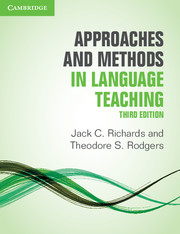Book contents
- Frontmatter
- Contents
- Acknowledgments
- Introduction to the third edition
- I Major trends in twentieth-century language teaching
- II Current approaches and methods
- III Alternative twentieth-century approaches and methods
- IV The teaching and learning environment
- Appendix: Comparison of approaches and methods
- Author index
- Subject index
17 - Community Language Learning
Published online by Cambridge University Press: 08 April 2022
- Frontmatter
- Contents
- Acknowledgments
- Introduction to the third edition
- I Major trends in twentieth-century language teaching
- II Current approaches and methods
- III Alternative twentieth-century approaches and methods
- IV The teaching and learning environment
- Appendix: Comparison of approaches and methods
- Author index
- Subject index
Summary
Introduction
Community Language Learning (CLL) is the name of a method developed by Charles A. Curran and his associates. Curran was a specialist in counseling and a professor of psychology at Loyola University, Chicago. His application of psychological counsel-ing techniques to learning is known as Counseling-Learning. CLL represents the use of Counseling-Learning theory to teach languages. As the name indicates, CLL derives its primary insights, and indeed its organizing rationale, from Rogerian counseling. Counseling, as Rogerians see it, consists of one individual (the counselor) assuming, inso-far as he or she is able, the internal frame of reference of the client, perceiving the world as that person sees it and communicating something of this empathetic understanding (Rogers 1951). In lay terms, counseling is one person giving advice, assistance, and support to another who has a problem or is in some way in need. CLL draws on the counseling metaphor to redefine the roles of the teacher (the counselor) and learners (the clients) in the language classroom.
Within the language teaching tradition, CLL is sometimes cited as an example of a “humanistic approach.” The content of the language class stems from topics learners want to talk about, and the teacher translates their requests into an appropriate syllabus. Links can also be made between CLL procedures and those of bilingual education, particularly the set of bilingual procedures referred to as language alternation or code switching. Let us discuss briefly the debt of CLL to these two traditions.
Because of the humanistic approach of CLL, the basic procedures can thus be seen as derived from the counselor–client relationship. Consider the following CLL proce-dures: A group of learners sit in a circle with the teacher standing outside the circle: a student whispers a message in the native language (L1); the teacher translates it into the foreign language (L2); the student repeats the message in the foreign language into an audio recorder; students compose further messages in the foreign language with the teacher's help; students reflect about their feelings. We can compare the client–counselor relationship in psychological counseling with the learner–knower relationship in CLL (Table 17.1).
Information
- Type
- Chapter
- Information
- Approaches and Methods in Language Teaching , pp. 303 - 316Publisher: Cambridge University PressPrint publication year: 2014
